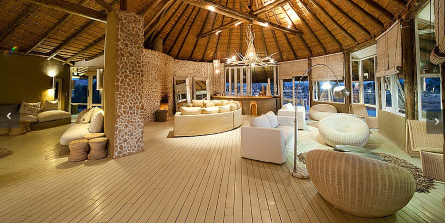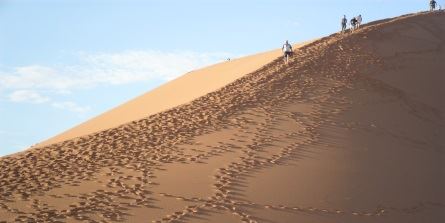Sossusvlei is famous for its huge, red sand dunes, some of the tallest in the world, and is one of Namibia’s most-visited attractions. Kim Emmanuel looks at what the area has to offer.
Sossusvlei is a salt and clay pan in the largest conservation area in Africa, the Namib-Naukluft National Park. “Images of this area are recognised worldwide and are icons of the land,” says Michéll Fourie, speaking in her former role as Commercial Services South Africa: Manager Sales & Marketing at Air Namibia, highlighting the uniqueness of the area.
Despite the low rainfall and lack of vegetation, the desert is filled with a number of insects, reptiles and rodents, says Mike Wassung, MD of Wilderness Safaris Namibia. Desert-adapted wildlife, such as ostrich, springbok and gemsbok, are sparsely scattered along the Tsauchab Valley. “It is the sheer scale and grandeur of the dunes that attract visitors to this ocean of sand.”
The word Sossusvlei originates from the Nama and Afrikaans languages and translates to ‘dead-end’. Strictly, Sossusvlei refers specifically to the salt and clay pan at the end of the Tsauchab River’s course, however, often the entire area, including Dune 45, Deadvlei and Hiddenvlei, is referred to as Sossusvlei.
At Sossusvlei, the dunes meet, preventing the Tsauchab River from flowing any further, hence its name. However, following an exceptional rainy season in the Naukluft Mountains, the pan is filled and appears as a lake, drawing visitors from all over the world to witness the sight.
How to get there
Fourie provides insight on access to the area. “Clients can fly into Windhoek on Air Namibia. From there it’s about a five-hour drive south to Sesriem and the lodges in the area. Alternatively, clients flying into Walvis Bay can drive from there to Sossusvlei, which takes approximately the same driving time.” The roads are gravel and safety needs to be taken extremely seriously in this area when driving, Fourie adds.
She says travellers who are pressed for time in Namibia can still have the opportunity to experience Sossusvlei. Atlantic Villa Boutique Guesthouse and Swakopmund Plaza Hotel offer a product called ‘Sossusfly’. “This is a two-and-a-half-hour scenic flight from Swakopmund over Sossusvlei and can include parts of the Skeleton Coast.”
Where to stay

Mariska Yntema, Product Developer at Jenman African Safaris, says a great sleep-out deck experience is available at Wilderness Safaris Little Kulala Camp and Kulala Desert Lodge. “Sleeping out under the stars is absolutely breath-taking in Namibia, with so little light pollution and clear night skies.”
Wilderness Safaris Little Kulala Camp and Kulala Desert Lodge are the closest luxury camps to the dunes, with a private access gate to Sossusvlei from the Kulala Wilderness Reserve.
Little Kulala Camp comprises 11 luxury rooms with private plunge pools, both indoor and outdoor showers and a rooftop star bed for romantic star gazing. An entertainment area includes a library, wine cellar, craft boutique, lounge and dining areas.
Activities include day and night game drives, guided walks and quad biking.
Kulala Desert Lodge comprises 23 thatched and canvas rooms with en-suite bathrooms and verandas. Each unit is built on a wooden platform to catch the cooling breezes and has a deck on the flat rooftop for sleep-outs under the stars. There are also three tents that can each accommodate a family of four.
The main area includes a lounge, bar, dining area, plunge pool, and wrap-around veranda overlooking the riverbed – a perfect location to view and photograph the desert vista.
Yntema also suggests Namib Dune Star Camp from the Gondwana Collection, which is close to Sossusvlei. The camp offers nine cabins, each with an en-suite bathroom, a large bedroom and a spacious deck. The rooms have a double bed designed to be wheeled out for a night under the southern skies.
An additional non-moveable single bed makes the cabin perfect for either families or friends.
Nearby attractions

Big Daddy is the tallest dune in the Sossusvlei area and is situated between Sossusvlei and Deadvlei. Guests can hike to the top of the dune and look down on to Dead Vlei.
Guido Roeschlau, Contracting Manager at Sense of Africa Namibia recommends visiting Dead Vlei, which can be reached shortly before Sossusvlei on a 1.1km walk. “After a short desert trail that ends behind a shallow dune, the image unfolding is completely and utterly awe inspiring, something you have never come across and something you will never find again anywhere on earth,” says Roeschlau. “Dead Vlei is an area that should not be missed on any Namibian safari.”
Dune 45 is named for its proximity to Sesriem Gate. It is 45km from the gate, along a paved road and is easily reached using a 2×4 vehicle. Visitors are recommended to climb Dune 45 early in the day to watch the sun rise over the vlei from the top of the dune. The dune is 85 metres high.
Hiddenvlei is a 2km walk from the end of the 2×4 track and the route is marked with wooden poles. This is the least-visited of all the vleis, allowing visitors the opportunity to experience some solitude in the desert surroundings.























